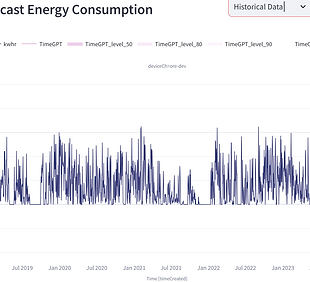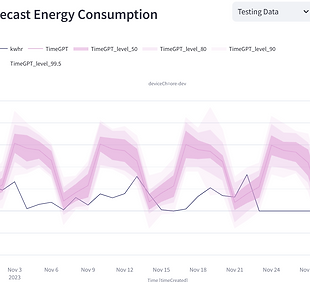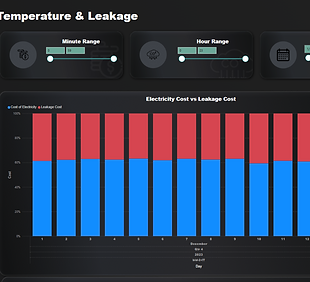
Case Studies
Predicative maintenance on a Wind Turbine

Predicative maintenance on wind turbines
Lnk Technologies delivered an innovative project to install IoT sensors on the Levenmouth Wind Turbine, operated by ORE Catapult, from November 2024 to February 2025. This project aied to enhance the functionality and efficiency of wind energy production through advanced sensor technology and data analytics. This project not only aimed to test and validate the performance of our IoT sensors but also seeks to leverage predictive AI and data analytics to optimize energy production and reduce maintenance costs.
Requirements
01.
Test robustness of the sensors in harsh windy conditions
02.
Test continuity of connectivity for reliable transmission of data
03.
Test ease and speed of installation of sensors on large, time sensitive equipment
04.
Analyse and display anomalies
05.
Alert management on deviation from expected energy production
Findings
01.
Frequent anomalies detected → Possible equipment failures or operational inefficiencies
02.
Sudden spikes → Unexpected energy surges due to peak loads or faults Sharp drops → Indicate downtime, maintenance, measures
03.
Significant deviation from forecast → Suggests inefficiencies or unplanned energy consumption
04.
There are dips in energy consumption that may suggest downtime in operations, equipment shutdowns, or power-saving measures. Management should investigate whether these are intentional (planned maintenance) or due to unexpected failures. The actual energy consumption often diverges from the predicted forecast, meaning operational changes impact energy usage.
Making the case for flying electric
London Airports Centre is a Pilot training school in Essex who is focused on reducing Carbon emissions of its activities and has the ambitious goal of becoming a NetZero flight training school by 2030.
They have a fleet of electric aircraft used for their training activities as well as traditional Cessna Aircrafts.
They wanted to showcase using science-based data the difference in carbon emissions compared to traditional aircrafts. They were also interested in demonstrating how running electric aircrafts are not only green but also cheaper than traditional aircrafts.
In addition, they wanted to plan for further decarbonization by installing solar panels on the site to power the planes and further reduce emissions. To do so, they needed to understand accurately their energy profile to calculate with precision the type and number of panels needed to effectively cover all their energy needs.
Requirements
01.
Capture accurate data on electricity consumed over time
02.
Calculate CO2 emissions of flying activities.
03.
Calculate solar panels needed to meet energy needs
04.
Analyse and display Return on Investment
05.
Provide consultancy and support in solar installation
Planning for Net Zero
London Airsports Centre, deterred by high energy prices and the desire to further decarbonize asked us to use the data we had collected on their energy profile to produce a proposal for the installation of Solar panels on the roof of the hangar where the Aircrafts are parked.
01
Calculating the equipment needed and ROI
CarbonLnk was able to calculate the ROI and the costs of the panel over the duration of the panel warranty.

02
Match the Performance of the panel with the needs
We were able to understand precisely how many panels were needed to cover electricity needs and after further discussions it was agreed that we would install in excess of what was needed as the roof space allowed for it. We were able to graphically demonstrate an individualized panel performance graph.
03
Graphic display of performance
The performance of the panels is displayed graphically to show differences in outputs over the day and the year
*Quote and installation provided by Generation Power

Findings
01.
The fuel cost of a flight with an electric plane is £6.6 compared to £15.1 and £22.7 for traditional planes ( 80hP and 110 hP ) , a difference of 78% and 109% respectively
02.
The CO2 emissions reduction of flying electric is 119% reduced ( 50.8 kgs vs 162 kgs and 203 kgs )
03.
The number of panels needed are 72 to cover the needs. the ROI is 18 months if remains on current tariff or 7 years assuming variable tariff over the years
04.
The company would need to plant 9040 trees if they wanted to offset their emissions for the year.
Electricity losses in former Central London Hospital

Understand high electricity bills
A former hospital building now repurposed for student accommodation is experiencing higher than expected electricity bills. The building managers need to understand this discrepancy and remedy any issues that cause the bills to be higher than normal.
The building managers have already commissioned a company to conduct an electrical testing and analysis. It did not show any discrepancies from the existing bill reading.
They asked Lnk Technologies to test the electrical installation to provide granular and real time data on electricity consumption.
Our challenge was to obtain accurate power readings from an antiquated old system without any wiring or schematic diagrams. Like most hospitals and large infrastructures, this site had the equivalent power of an electrical substation, approx. 5 MW.
We were able to show real time energy use and losses as well as make recommendations on how to improve the electrical wiring to reduce losses. We also monitored energy spikes to alert of fire hazards.
Requirements
01.
Electricity output measurement
02.
Ambient temperature measurement
03.
Electricity leakage information
04.
Electrical surges / fire hazards notifications
05.
GHG emissions scope 2 in real time
Energy audit on a terraced 3 bedroom house

identifying quick savings
A property management company undertook a large retrofit project to improve energy ratings and achieve savings across their portfolio.
They asked Lnk Technologies to conduct an energy audits on a typical residential 3-bedroom Victorian house as a test bed to estimate potential saving across the portfolio.
We installed our IoT sensors to capture leakage and electrical inputs on the main electrical board.
For the house, our energy audit revealed that energy losses were at 15.19%. Our AI analysis identified the fridge and kitchen lighting as the biggest energy consumers.
CarbonLnk recommended replacing the fridge with an AAA* energy-rated model and installing LED lighting in the kitchen. These upgrades resulted in significant electricity savings.
Requirements
01.
Show break down of electricity consumption in the house
02.
identifying highest type of electrical loss/ consumption
03.
Recommend cost effective improvements to save energy
04.
understand health and safety audit of electrical installation
05.
calculate reduction of Co2 emissions made by improvements
Lighting: Reduced from 24% to 7%, achieving a 17% savings.
Fridge leakage: Accounted for 9% savings.
In total, these changes led to a 26% savings on electricity.
With an average monthly bill of £74, this translates to a £19 savings per month. Annually, this means a bill of £888, with actualized savings of £230 per year.
The return on investment of these simple but targeted fixes allowed the customer to realize significant energy savings based on the insight provided by our AI powered energy audit.
In addition, we provided accurate GHG emissions data to our clients to show them how managing their energy was also significantly reducing their carbon footprint.


















.png)

.png)
.png)